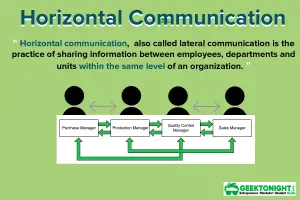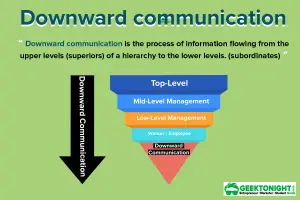Introduction Upward and Downward Communication
The difference between upward and downward communication depends mainly on the flow of communication within any organization. The communication method which transfers the information from subordinates to seniors is upward communication and vice-versa i.e. seniors to subordinates is a downward communication. These two different channels of communication have different modes to transfer information, which varies from organization to organization.
Table of Content
- 1 Introduction Upward and Downward Communication
- 2 Difference between Upward and Downward Communication
- 3 What is Upward Communication?
- 4 What is Downward Communication?
- 5 Similarities between Upward and Downward communication
- 6 Key differences between Upward and Downward communication
- 7 Conclusion
- 8 Business Communication Notes
Communication is a key element of every workplace. In any organization, most of the communication flows internally, so it’s very important to have effective internal communication. Internal communication takes place in two ways – Upward Communication and Downward Communication.
Now, let’s discuss the difference between upward and downward communication.
Difference between Upward and Downward Communication
| Parameters | Upward Communication | Downward Communication |
|---|---|---|
| Objective | To exchange feedback, suggestions, complaints, requests, and opinions. | It emphasizes communicating organizational goals, policies, procedures, targets, and upcoming events along with instructions, orders, and directions of the superiors to subordinates. |
| Flow | Bottom to top, i.e., subordinates to seniors. | Top to bottom, i.e., seniors to subordinates. |
| Frequency | Less frequent as compared to downward. | Very frequent in performing all the organizational activities. |
| Purpose | It’s the voice of employees to make complaints, give feedback and suggestions. | Passing instructions, orders, advice, or assigning responsibilities in the organization. |
| Nature | It is participative in nature and opinions are collected from various team members. | It is basically authoritative & directive in nature. |
| Coverage | Sometimes it’s related to only concerned departments of an organization. | It covers majorly the whole organization. |
| Transparency | High chances of misleading the information and changing the messages. | Mostly transparent, less distortion of information. |
| Speed | Slow | Fast |
| Form | Reports, suggestion box, meetings | Circulars, notices, audio-visual media |
What is Upward Communication?
Upward Communication occurs when the information flows from the ground level of the organization (team members, employees, and workforce) to the upper level of the organization (managers, senior staff). This flows step by step in the reverse hierarchical manner. In this mode of communication, the advanced chain of transferring information is followed rather than the traditional method of communication.
This mode of communication is highly observed in this latest era of a highly competitive market. Some of the examples of upward communication are – collect feedback, complaints, suggestions, performance reports, satisfaction surveys, and effective functioning surveys. Noticing all this information collected from ground level and addressing them is highly important.
Upward communication is seen highly active in recent decades previously only traditional mode of downward communication was mostly followed. The prime objective of the introduction of this channel is to increase the growth rate much faster and empower the workforce. This is the way of addressing the concerns of every employee and make them feel like a contributor to the growth process. Upward communication also helped in retaining the interest of employees in the organization.
What is Downward Communication?
Downward Communication occurs when the information flows from the upper level of the organization (managers, senior staff) to the ground level of the organization (team members, workforce). This flows step by step in a hierarchical manner. In this mode of communication, the formal chain of transferring information is followed and the message is made to reach the ground level team as precisely as possible.
In this type of communication different media can be used to exchange the information. Such as through e-mails, meetings, announcements, letters. The information exchanged is related to a large group of people and most of them have a common objective. It is highly frequent and executed at regular intervals for the effective functioning of the firm.
The prime objective of this communication is to communicate the organizational goals, strategies, activities, programs, important processes related to the functioning of an organization. It also helps employees to understand the basic duties and relate their job roles to others working in the organization. It is considered as the initiator because it acts as the initial step of every planned function of the company.
The execution of this exchange of information is highly important. The improper management of sending the information or message in time, may lead to a communication gap and lead to various unwanted consequences. These consequences ultimately hinder the performance of the organization. Downward communication plays a key role in pertaining organization’s objectives and policies.
Similarities between Upward and Downward communication
- Both upward and downward communications are an integral part of Internal Communication.
- Both equally contribute in enhancing the performance of the organization.
- Both the channels have certain limitations according to the oriented goal and objective.
- Both cover the whole organization in the wider aspect.
- Both are equally important to eliminate the communication gap of the people working in the organization.
Key differences between Upward and Downward communication
- The direction of flow of communication in upward communication flows from bottom to top, whereas in downward communication, it flows from top to bottom.
- The frequency of occurrence of upward communication is low compared to downward communication.
- The nature of upward communication is participative, while the nature of downward communication is authoritative.
- Upward communication is the voice of employees to make complaints, give feedback, and suggestions. Unlike, downward communication, which is used to pass instructions, orders, advice, or assigning responsibilities in the organization.
- Due to nature, the speed of upward communication is slower compared to downward communication.
- Downward communication dominates upward communication is a traditional practice.
- The common forms of upward communication are reports, suggestion boxes, & meetings. On the contrary, the common forms of downward communication are circulars, notices, audio-visual media.
Conclusion
From a growth mindset perspective, downward and upward communication, both are equally important for any organization to grow inclusively. Downward communication helps us to share the information to every ground level department of the organization which has been passed from top-level management and upward communication helps to collect the feedback from ground level to the top-level management.
In order to reach the set goals and targets, proper monitoring of both the communication channels is highly required.
Business Communication Notes
(Click on Topic to Read)
[simple-author-box]
Business Communication Notes
(Click on Topic to Read)
- What is Business Communication?
- What is Communication?
- Types of Communication
- 7 C of Communication
- Barriers To Business Communication
- Oral Communication
- Types Of Non Verbal Communication
- What is Written Communication?
- What are Soft Skills?
- Interpersonal vs Intrapersonal communication
- Barriers to Communication
- Importance of Communication Skills
- Listening in Communication
- Causes of Miscommunication
- What is Johari Window?
- What is Presentation?
- Communication Styles
- Channels of Communication
- Hofstede’s Dimensions of Cultural Differences and Benett’s Stages of Intercultural Sensitivity
- Organisational Communication
- Horizontal Communication
- Grapevine Communication
- Downward Communication
- Verbal Communication Skills
- Upward Communication
- Flow of Communication
- What is Emotional Intelligence?
- What is Public Speaking?
- Upward vs Downward Communication
- Internal vs External Communication
- What is Group Discussion?
- What is Interview?
- What is Negotiation?
- What is Digital Communication?
- What is Letter Writing?
- Resume and Covering Letter
- What is Report Writing?
- What is Business Meeting?
- What is Public Relations?
Business Communication Notes
(Click on Topic to Read)
- What is Business Communication?
- What is Communication?
- Types of Communication
- 7 C of Communication
- Barriers To Business Communication
- Oral Communication
- Types Of Non Verbal Communication
- What is Written Communication?
- What are Soft Skills?
- Interpersonal vs Intrapersonal communication
- Barriers to Communication
- Importance of Communication Skills
- Listening in Communication
- Causes of Miscommunication
- What is Johari Window?
- What is Presentation?
- Communication Styles
- Channels of Communication
- Hofstede’s Dimensions of Cultural Differences and Benett’s Stages of Intercultural Sensitivity
- Organisational Communication
- Horizontal Communication
- Grapevine Communication
- Downward Communication
- Verbal Communication Skills
- Upward Communication
- Flow of Communication
- What is Emotional Intelligence?
- What is Public Speaking?
- Upward vs Downward Communication
- Internal vs External Communication
- What is Group Discussion?
- What is Interview?
- What is Negotiation?
- What is Digital Communication?
- What is Letter Writing?
- Resume and Covering Letter
- What is Report Writing?
- What is Business Meeting?
- What is Public Relations?













Differeniat between upward and downward communication it least three example in university